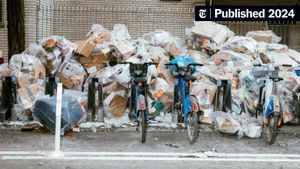Los Angeles, California continues to grapple with devastating wildfires, with the latest infernos igniting on January 7, 2025, claiming at least 29 lives and destroying over 16,000 homes. These catastrophic events are increasingly linked to human-caused climate change, as rising global temperatures create conditions primed for such extreme disasters.
According to research from the World Weather Attribution group, the combination of reduced rainfall, dried-out vegetation, and intensified interactions with powerful Santa Ana winds have made these wildfires not just more likely, but also more ferocious. With winds reaching up to 100 miles per hour, these conditions create what some researchers have termed as tinderbox scenarios.
Dr. Clair Barnes, a researcher at the World Weather Attribution, presents stark findings: "Climate change increased the risk of the devastating LA wildfires. Drought conditions are more frequently pushing... without... fossil fuels, California will continue to get hotter, drier, and more flammable." The flames are not just ripping through forests; they are encroaching firmly onto urban lands, threatening homes, businesses, and entire neighborhoods.
A community's response to these repeated calamities has been fraught with tension, particularly surrounding land use and housing. Months prior to the wildfires, residents of Altadena found themselves embroiled in discussions over new zoning laws intended to mitigate risks associated with living near wildfire-prone areas. Proponents argue the need for these restrictions is clear, especially after the Eaton Fire resulted in extensive destruction.
Critics, on the other hand, argue against limiting housing development, citing property devaluation and their rights as landowners. Roop Singh, head of Urban and Attribution at the Red Cross Red Crescent Climate Centre notes, "Climate change set the stage, helping turn the hills around LA tinder-dry. Hurricane-force Santa Ana winds made the blazes extremely difficult to contain." Striking this balance between housing needs and safety is going to define Los Angeles’s future land use, and many are unsure if local policymakers will effectively confront these intertwined issues.
While California is rich with history of wildfires, the past decade has demonstrated increasing frequency and intensity due to climate shifts—conditions exacerbated by human activity. Reports indicated 312 separate wildfires have already charred 57,509 acres as of 2025. The immediacy of the crisis cannot be overstated. Families, including those like the Arnzen family, who lost their home, describe the situation as surreal—"My fridge turned to dust... it was completely gone." This echoes the sentiments of many, as the emotional toll combined with the material devastation paints a tragic portrait of community upheaval.
Data-driven studies establish the clear relationship between climate change and heightened wildfire risks. Using advanced computer modeling, researchers can evaluate specific events, helping governments and policymakers understand and predict the relationship between our warming planet and these extreme weather occurrences.
Nevertheless, the urgency of addressing climate change is met with bureaucratic hesitation at various levels of government. Jennifer Balch, professor of geography, asserts, "We cannot expect to live... and expect firefighters to manage flammable landscapes. This is something we need to address well before the fire actually ignites." The push for reform seems blocked by long-standing interests as housing demands and fire safety collide.
Los Angeles's fighting spirit remains resilient, though. The message resonates: "The earth is burning, and we have the power to stop it," as expressed by one community advocate who implores residents to engage with the urgent climate crisis. The path forward must include not only effective firefighting strategies but also serious discussions about sustainable growth, energy transitions, and community resilience. This catastrophic series of events should not be seen as isolated instances but as interconnected parts of our climate’s response to human activity.
The stakes aren’t merely about land and property; they encompass future generations and the ecosystems we owe protection. Before another fire season starts, the time to unite action against climate change and unyielding wildfire threats is now, calling for clear-eyed leadership and courageous decision-making.



